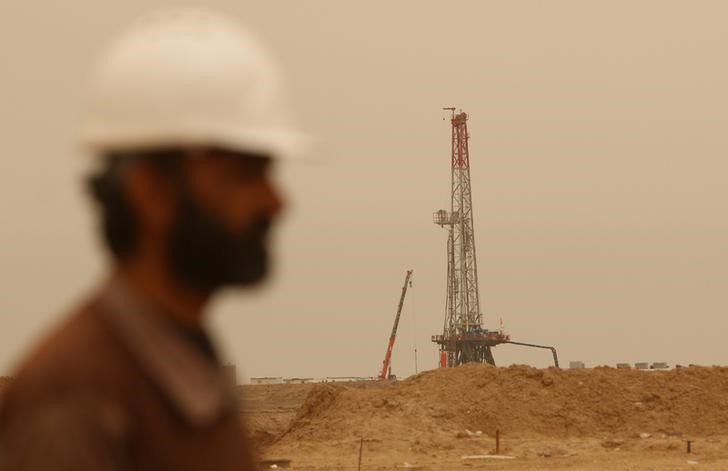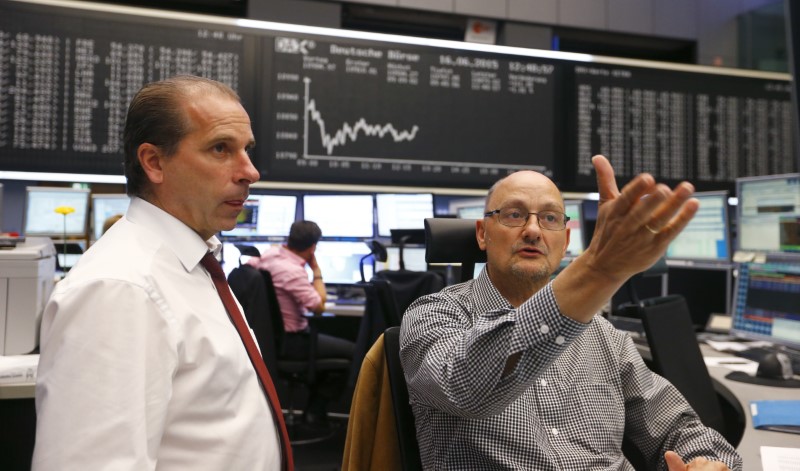
Drilling equipment is seen at the Sindbad oil field near the Iraqi-Iranian border in Basra, Iraq April 23, 2018. Picture taken April 23, 2018. REUTERS/Essam Al-Sudani
May 31, 2018
By Amanda Cooper
LONDON (Reuters) – Brent crude prices reversed earlier losses to hit their biggest premium against U.S. futures in over three years on Thursday, as the prospect of more inventory increases weighed heavily on West Texas Intermediate prices.
At 1221 GMT, Brent crude futures were up 6 cents at $77.78 a barrel, while U.S. West Texas Intermediate crude slid 68 cents to $67.53 a barrel.
That pushed the premium of Brent to WTI beyond $10 a barrel, the largest since March 2015. That spread has doubled in less than a month, as a lack of pipeline capacity in the United States has trapped a lot of output inland.
“The Brent/WTI is blowing out. I think there must be what looks like some capitulation going on in the spread between those two contracts,” Saxo Bank senior manager Ole Hansen said.
The wider premium makes U.S. crude exports more competitive than those linked to the Brent price, such as North Sea or West African grades of oil.
U.S. crude stockpiles rose by 1 million barrels in the week to May 25, according to the American Petroleum Institute (API). Analysts had expected a drop of 525,000 barrels, which dented U.S. futures earlier in the day. [API/S]
Brent meanwhile slid to a three-week low below $75 a barrel on Monday after the Organization of the Petroleum Exporting Countries and its non-OPEC allies including Russia indicated they could adjust their deal to curb supplies and increase production.
Sources told Reuters that Saudi Arabia, the effective leader of OPEC, and Russia were discussing boosting output by about 1 million barrels per day (bpd) to compensate for losses in supply from Venezuela and to address concerns about the impact of U.S. sanctions on Iranian output.
“The fact that we saw the Saudi/Russia announcement last week could have attracted some interest in narrowing the spread, given that we were looking for some of the geopolitical risk (in Brent) to be removed, but that’s been overtaken by the domestic widening in crude prices in the U.S.,” Hansen said.
Prices for physical barrels of U.S. light sweet crude delivered at Midland are at their largest discount to the benchmark U.S. futures price in almost four years. [CRU/O]
“U.S. shale is alive and well and growing at an annual rate well in excess of 1 million bpd,” consultant JBC Energy said in a report. “Growth is expected to remain in place, but widening crude differentials due to infrastructure bottlenecks do actually speak in favor of a slowdown in growth.”
OPEC and non-OPEC producers have committed to cut output by 1.8 million bpd until the end of 2018 but will decide at a meeting in late June whether to prolong this.
“If this is a real correction, then the price should get down to the low $70s or even the mid-$60s,” SEB chief commodities analyst Bjarne Schieldrop said. “The market needs to be cautious ahead of the OPEC meeting.”
(Additional reporting by Roslan Khasawneh in Singapore and Jane Chung in Seoul; Editing by Edmund Blair and Susan Fenton)

